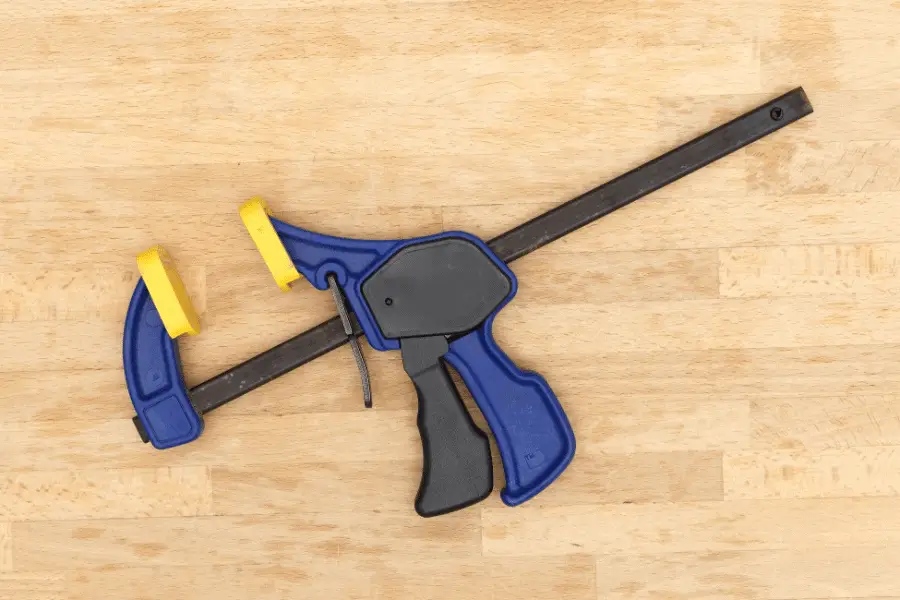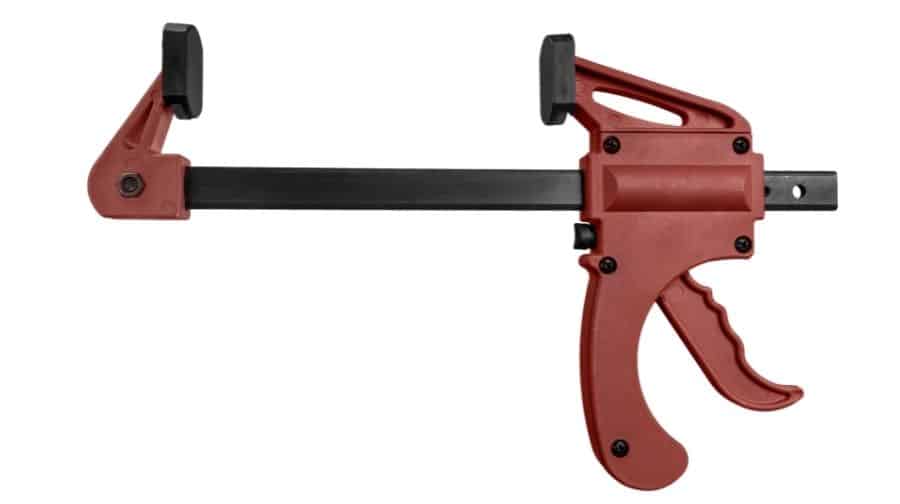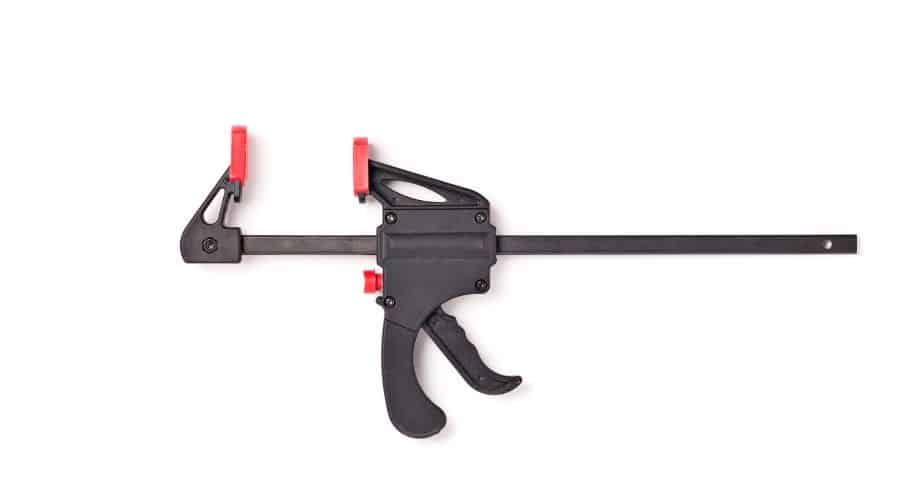
Quick grip clamps also known as quick action clamps, quick clamps, quick release clamps and trigger clamps are easy and versatile clamps for woodworking or any DIY project.
There are so many helpful options when it comes to clamps for your project. Each clamp has a specific purpose and function that separates it from the others. I’ve researched through the internet and put together a quick summary on quick grip clamp.
What are quick grip clamps used for? The quick grip clamp can be used with one hand to lock and release on your project. They are commonly used for gluing woodworking joints, gluing wood panels and at home DIY projects.
Keep reading below to learn more about the quick grip clamp and what it can be used for.
Recommended Resource: Free “Art Of Woodworking” Guide
What Are Quick Grip Clamps Used For?
The quick grip clamp is a swift and highly versatile clamping tool that is used where speed in clamping is the priority. It is a clamp designed with a mechanism that allows the user to open and close the jaws swiftly in a single movement. It is sometimes referred to as the quick-release clamp due to how quickly it can clamp a workpiece and release it from the grip. This clamp is very popular and useful to DIYers as well as professionals because of the ease in using it. It offers very powerful and reliable clamping with a minimum effort.
The clamp could also be easily referred to as a one-handed clamp because it can be tightened and released using just one hand. It might not sound like much but having one hand always free is a big advantage to users of the quick-action tool. This tool is perfect for the type of work that requires you to perform it with one hand, for example, overhead tasks, or if another tool needs to be used as the clamping is being done.
This is also a big advantage in situations where you need to grip large or heavy objects and hold the workpiece with your other hand till it is in place. The one-handed operation allows you to have the pieces of the workpiece quickly in place and are very useful in complicated or fussy jobs.
The quick grip clamp usually comprises a spindle which has a rolled thread to provide ease of movement and to have the maximum clamping force. It also has a fixed jaw and a sliding jaw which are both drop forged and made from hardened and tempered carbon tool steel. It also contains a locking pawl installed to prevent the accidental opening of the clamp.
The quick grip clamp comes in three different types, namely:
- The Lever Clamp: This is a very strong and sturdy type of quick grip clamp that can be used for many types of projects. The clamp comes in an elevated form so there is very little effort needed to close the jaws as the movable jaw only needs to be slid downwards. The whole process of clamping and releasing can all be performed in a single swift motion. Some lever quick grip clamps utilize a ratchet mechanism in the clamp so it is locked immediately; pressure is applied to the lever and is released by pressing a trigger on the lever. This helps in providing sufficient clamping pressure on the workpiece.
- The Spring Clamp: This clamp is sometimes referred to as a pinch clamp or a hand clamp, is a small device quite similar to a clip, used for gripping small pieces. The device has quite a plain structure comprising of two handles and two jaws, which do the actual gripping, as well as a spring pivot in the center of the clamp. The handles are pressed together to lock the workpiece with the jaws. This clamp is best used on small repair work and holding small pieces together for painting or gluing.
- The Trigger Clamp: Trigger clamps are possibly the easiest to use out of the three types. The trigger mechanism allows the jaws of the clamp to be easily opened and closed with one hand. When the trigger is pressed, the moveable jaw slides towards the fixed jaw, allowing them to be closer together and also making for quick and easy placement of the workpiece and the clamp. This clamp can easily be used in the home, office, and even workshop. It is quite efficient in holding together large or heavy pieces.

Curious about What Is A C-Clamp Used For? Please consider reading our article about the topic at this link here https://topwoodworkingadvice.com/what-is-a-c-clamp-used-for/
Recommended Post: Top Woodworking Jokes
Quick Action Bar Clamp Overview
Subscribe to Highland Woodworking on Youtube
Quick Action Clamp Overview
Subscribe to Unior HandTools on Youtube
Recommended Post: Top Woodworking Memes
How Do Quick Grip Clamps Work?
The quick grip clamp is a very easy tool to use and it is very efficient. The first step to take when you want to use a quick grip clamp is to place the jaws of the clamp in the right position relative to the workpiece to be clamped. Although, how you position the jaws will depend on the type of quick grip clamp you are using.
For example, the jaws in the spring clamp are operated with the handles. The jaws need to be opened up so the workpiece can be inserted in between. On other types of clamps, the moveable jaw could just be easily slid along the bar until it is opened sufficiently for the workpiece to be placed in it.
After the claws have been opened sufficiently for the workpiece to be placed in it, the jaws can then be tightened around the workpiece. The jaws of the clamp should be firmly tightened.
If a spring clamp with offset jaws is in use, you should just let go of the handles and the jaws will close automatically. But if the spring clamps have crossover jaws, you should push the handles together and lock the quick-release lever to keep the piece in place. If a lever clamp is in use, just press the lever down to close the jaws around the workpiece.
When the lever is pressed down, the moveable jaw is locked into place to prevent it from sliding down the bar. The clamping pressure can easily be increased or reduced by simply unlocking the trigger and moving the moveable jaw until the pressure needed is gotten.
Compared with conventional bar clamps, the quick action clamp has a much lower clamping strength as it can not exert as much pressure.
For instance, when gluing heavy workpieces together, the quick grip clamps could easily reach their limits and a heavy clamp would be needed. Also, for the larger tasks, multiple clamps may be required to hold the workpiece effectively and for the duration of the work being performed. This could prove to be a disadvantage in terms of the cost of multiple clamps but it is still extremely efficient in the quick clamping of workpieces.
The quick grip clamp is very useful for industrial locksmithing and in the wood industry. It should be cared for well and all moving parts of the clamp should be well oiled and kept clean to prevent any slipping. There should also be no dirt or oil on any part of the clamp that comes in contact with the workpiece.

Curious about What Is A Bar Clamp Used For? Please consider reading our article about the topic at this link here https://topwoodworkingadvice.com/what-is-a-bar-clamp-used-for/
Recommended Post: Top Woodworking Resources
How Do You Convert A Clamp To Spreader?
Subscribe to MAD4TOOLS on Youtube
Best Quick Grip Clamps
Curious about What Are Corner Clamps Used For? Please consider reading our article about the topic at this link here https://topwoodworkingadvice.com/what-are-corner-clamps-used-for/
